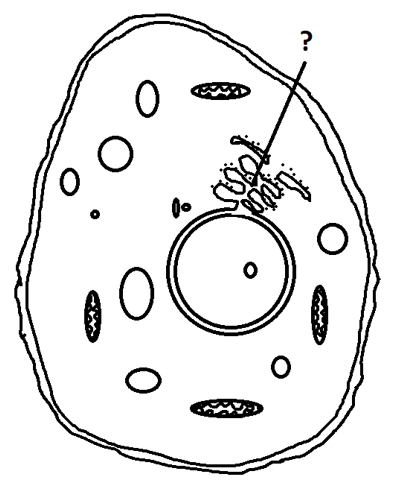This set of Class 11 Biology Chapter 8 Multiple Choice Questions & Answers (MCQs) focuses on “Eukaryotic Cells and it’s Organelles – 3”.
1. Identify the structure.

a) Mitochondria
b) Nucleus
c) Golgi apparatus
d) Endoplasmic reticulum
View Answer
Explanation: The structure shown in the diagram is the endoplasmic reticulum. Its membrane, which is a phospholipid bilayer, is continuous with the membrane of the nucleus. Rough endoplasmic reticulum is shown here.
2. What is the space inside the endoplasmic reticulum called?
a) Tubular compartment
b) Extra – tubular compartment
c) Luminal compartment
d) Extra – luminal compartment
View Answer
Explanation: The endoplasmic reticulum is an organelle whose membrane is continuous with the membrane of the nucleus. It divides the intracellular space into two compartments – luminal and extra – luminal.
3. Where are the ribosomes attached in rough endoplasmic reticulum?
a) In the lumen
b) On the folds towards the nucleus
c) On the surface
d) On the folds towards the cell membrane
View Answer
Explanation: Endoplasmic reticulum is of two types- smooth endoplasmic reticulum and rough endoplasmic reticulum. The rough endoplasmic reticulum has ribosomes present on its outer surface.
4. What is present on the surface of the rough endoplasmic reticulum?
a) Ribosomes
b) Peroxisomes
c) Lysosomes
d) Endosomes
View Answer
Explanation: Endoplasmic reticulum is of two types- smooth endoplasmic reticulum and rough endoplasmic reticulum. The rough endoplasmic reticulum has ribosomes present on its outer surface.
5. Endoplasmic reticulum without ribosomes is called ______
a) rough endoplasmic reticulum
b) smooth endoplasmic reticulum
c) non – ribosomal endoplasmic reticulum
d) nuclear endoplasmic reticulum
View Answer
Explanation: Endoplasmic reticulum is of two types – smooth endoplasmic reticulum and rough endoplasmic reticulum. The rough endoplasmic reticulum has ribosomes present on its outer surface.
6. Which of these cell organelles is involved in protein synthesis?
a) Lysosome
b) Smooth endoplasmic reticulum
c) Rough endoplasmic reticulum
d) Peroxisome
View Answer
Explanation: The rough endoplasmic reticulum contains ribosomes on its surface. Hence, the rough endoplasmic reticulum is actively involved in protein synthesis. Smooth endoplasmic reticulum is involved in lipid synthesis.
7. Which of these statements is not true regarding rough endoplasmic reticulum?
a) The inner compartment is called the tubular compartment
b) It is involved in protein synthesis
c) Ribosomes are attached to its outer surface
d) Its membrane is continuous with the outer membrane of the nucleus
View Answer
Explanation: The inner compartment of the rough endoplasmic reticulum is called the luminal compartment. The ribosomes are attached to the outer surface and it is actively involved in protein synthesis.
8. What is the site of production of lipid-like steroidal hormones in animal cells?
a) Mitochondria
b) Nucleus
c) Peroxisomes
d) Smooth endoplasmic reticulum
View Answer
Explanation: Smooth endoplasmic reticulum is the site of synthesis of lipid-like steroidal hormones. It is the major site for the production of lipids. Rough endoplasmic reticulum is the site of synthesis of proteins.
9. What is the diameter of cisternae of Golgi bodies?
a) 5μm to 10μm
b) 0.05μm to 0.1μm
c) 0.5μm to 1.0μm
d) 50μm to 100μm
View Answer
Explanation: Golgi bodies were named after the scientist who discovered them, Camillo Golgi. Golgi bodies contain flat, disc – shaped sacs called cisternae. The diameter of the cisternae is 0.5μm to 1.0μm.
10. The forming face of the Golgi complex is convex. True or false?
a) True
b) False
View Answer
Explanation: The Golgi complex is made of sacs called cisternae. The forming face which faces the nucleus is convex or cis, while the maturing face which faces away from the nucleus is concave or trans.
11. Which of these is not a function of the Golgi apparatus?
a) Packaging of proteins
b) Modification of proteins
c) Synthesis of glycoproteins and glycolipids
d) Synthesis of proteins
View Answer
Explanation: Golgi bodies are involved in the synthesis of glycoproteins and glycolipids. They are also involved in the modifications and packaging of proteins received from the endoplasmic reticulum. It does not synthesize proteins.
12. Which of these is not a lysosomal enzyme?
a) Lipases
b) Protease
c) Kinases
d) carbohydrase
View Answer
Explanation: The lysosome contains various enzymes collectively known as lysosomal acid hydrolases. The enzymes are hydrolytic enzymes such as lipase, protease and carbohydrase. Kinases are not hydrolytic enzymes.
13. Which of these statements is false regarding lysosomes?
a) They are bound by a single membrane
b) They contain hydrolytic enzymes
c) Lysosomal enzymes are active at a basic pH
d) They can digest nucleic acids
View Answer
Explanation: Lysosomes are bound by a single membrane. The contain hydrolytic enzymes which are active at an acidic pH and digest substances such as carbohydrates, proteins, lipids and nucleic acids, by hydrolysis.
14. What are the membranes of vacuoles called?
a) Tonoplast
b) Leucoplast
c) Amyloplast
d) Chromoplast
View Answer
Explanation: Vacuoles are covered by a single membrane known as tonoplast. Vacuoles contain substances for storage such as water, or excretory products such as sap and other materials not useful for the cell.
15. Which of these is a function of the contractile vacuole in Amoeba?
a) Lipoprotein synthesis
b) Osmoregulation of the cell
c) Glycoprotein synthesis
d) Degradation of nucleic acids
View Answer
Explanation: Vacuoles contain substances for storage such as water, or excretory products such as sap and other materials not useful for the cell. the contractile vacuole in Amoeba is responsible for osmoregulation and excretion.
Sanfoundry Global Education & Learning Series – Biology – Class 11.
To practice all chapters and topics of class 11 Biology, here is complete set of 1000+ Multiple Choice Questions and Answers.
If you find a mistake in question / option / answer, kindly take a screenshot and email to [email protected]
- Practice Class 11 - Mathematics MCQs
- Practice Class 11 - Chemistry MCQs
- Practice Class 11 - Physics MCQs
- Check Class 11 - Books
- Practice Class 12 - Biology MCQs
